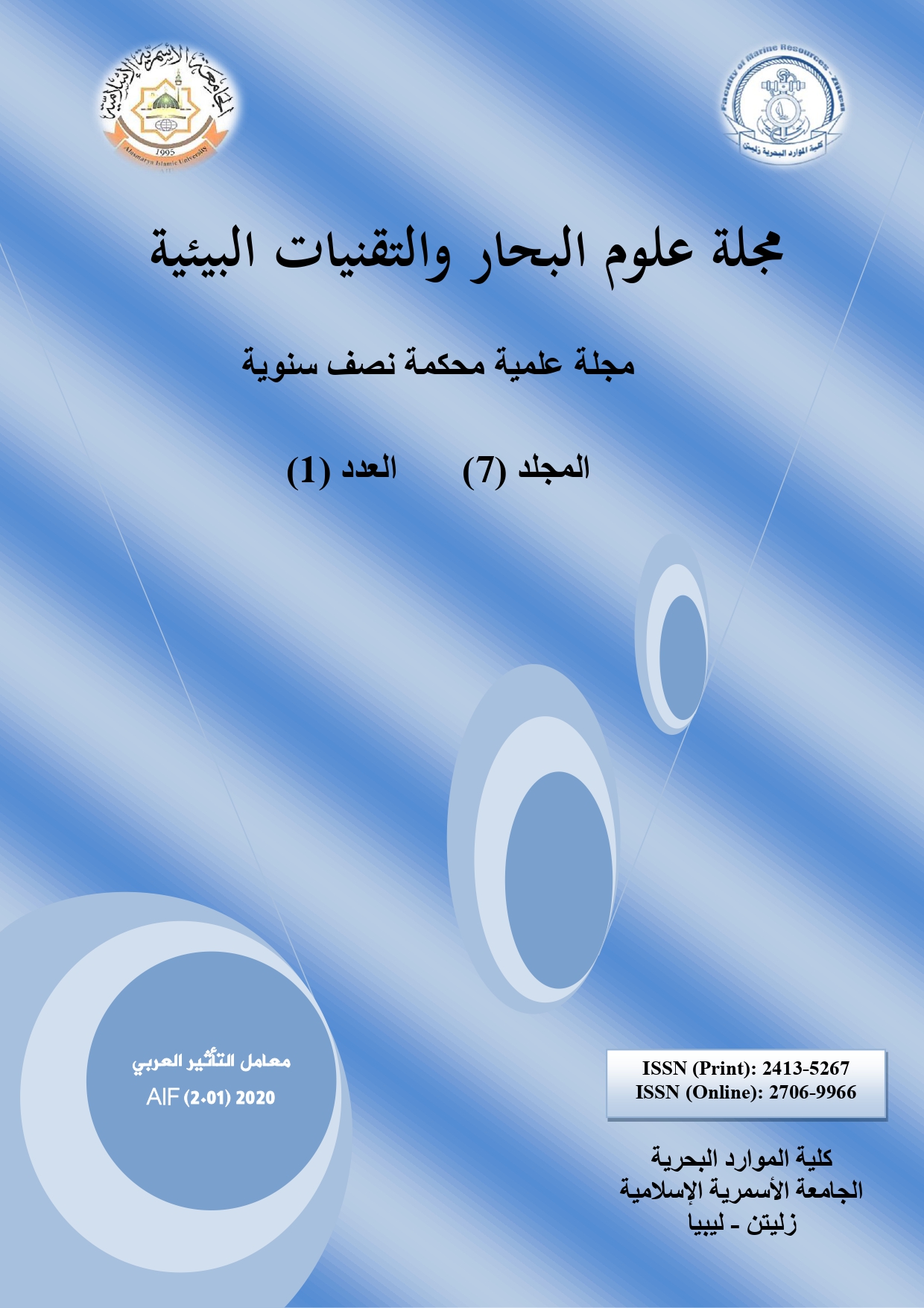دراسة التحلل الحيوي للنفط الخام بواسطة عزلات بكتيرية معزولة من ميناء الحريقة، طبرق، ليبيا
DOI:
https://doi.org/10.59743/jmset.v7i1.32الكلمات المفتاحية:
بكتيريا بحرية، تحلل حيوي، عزل، نفط خامالملخص
أشارت الأبحاث في مجال معالجة التلوث النفطي إلى الدور المهم الذي يمكن أن تلعبه الكائنات الحية الدقيقة في معالجة هذا التلوث، وبالتالي المعالجة البيئية، حيث يمكنها استخدام الهيدروكربونات البترولية كمصدر وحيد للكربون. لذا تهدف هذه الدراسة إلى عزل البكتيريا المسببة للتحلل الحيوي للنفط الخام من ميناء الحريقة بمدينة طبرق. حيث نمت 22 عزلة بكتيرية من ميناء الحريقة على وسط سائل يحتوي على زيت خام كمصدر وحيد للكربون. ثم نمت العزلات في خمسة تراكيز زيت مختلفة وهي (1٪، 5٪، 10٪، 25٪، 50٪). أظهرت بعض العزلات (W1Cb و W2Aa و W2Ab و W2Ca و W3Ba و W3C و W4Aa) قدرات تفاضلية على النمو تصل إلى 50٪ زيت. تم تحديد هذه العزلات البكتيرية المختارة (W2Aa و W2Ca و W3Ba و W3C و W4Aa) باستـــــــــــــــــــــــــــــخدام منهجية 16S rRNA في النيوكليوتـــــــــــــــــــــــــيد الأوروبـــــــــــــي مثـــــل Marinobacter hydrocarbonoclasticus و Vibrio hepatarius و ibrio alginolyticus و Vibrio parahaemolyticus على التوالي. وتم قياس الكثافة البصرية (OD) كتجربة تقيميه وكمؤشر رئيسي على النمو الميكروبي في النفط الخام عند تركيز 1%، بينت نتائج قياسات (OD) لمعدلات نمو العزلات قدرتها على النمو في فترة زمنية قصيرة 7 أيام واستمرارها في النمو لأكثر من 21 يوم. وكتجربة أخرى لتقييم تحلل النفط الخام باستخدام البكتيريا تم إجراء تحليل (GC) لخمس مستنبتات بكتيرية وأشارت نتائج هذا التحليل إلى أن أعلى فاعلية لتحلل النفط الخام تم في مستنبتات العزلة البكتيرية Vibrio alginolyticus والذي وصل إلى (95.23%)، بينما لوحظ أقل نسبة تحلل (47.61%) والتي قامت بها بكتيريا Marinobacter hydrocarbonoclasticus و Vibrio parahaemolyticus. نستنتج من نتائج الدراسة أن البكتيرية المحلية المعزولة Marinobacter hydrocarbonoclasticus و Vibrio hepatarius و Vibrio alginolyticus و Vibrio parahaemolyticus و Eubacteriumcombesii لديها قدرة جيدة على تحلل الزيت الخام، لذلك يمكن استخدامها في المعالجة الحيوية للتلوث الناجم عن النفط الخام.
التنزيلات
المراجع
أولاً: المراجع باللغة العربية
ابورويضة, عبد الله (1978). بروتين النفط. منشورات معهد الإنماء العربي، طرابلس، ليبيا.
بن الصادق، عبد الوهاب رجب هاشم (2002). الأمن البيئي. النشر العلمي والمطابع، جامعة الملك سعود، الرياض، السعودية.
البياتي، رضا إبراهيم؛ ضباب، جميل موسى (2005). استحداث طريق استخلاص كروماتوغرافيا الغاز لفصل وتقدير بعض المركبات الهيدروكربونية في النفط الخام وعينات صخرية. مجلة كلية التربية, 3: 1-14.
عبد الحميد، زيدان هندي وعبدالمجيد، محمد إبراهيم (1996). الملوثات الكيميائية والبيئة. الدار العربية للنشر والتوزيع، القاهرة، مصر.
عويد، ياسين حسين (2008). الفعل الانفرادي والمشترك لبعض العزلات البكتيرية في التحلل الحيوي لنفط خام القيارة. مجلة علوم الرافدين، 19: 101-115.
ثانياً: المراجع باللغة الإنجليزية
Abbot B.J. and Gledhi W.E. (1971). The extracellular accumulation of metabolic products by hydrocarbon degrading microorganisms. Adv. Appl. Microbiol., 14: 249-388.
Arvin E., Jensen B.K., and Gundersen A.T. (1989). Substrate interactions guring aerobic biodegradation of benzene. Appl. Environ. Micrbiol., 55(12): 3221-3225.
Atlas R.M. (1981). Microbial degradation of petroleum hydrocarbons: an environmental perspective. Microbial. Rev., 45(1): 180-209.
Atlas R.M. (1991). Microbial hydrocarbon degradation bioremediation of spill. Journal of Chemical Technology & Biotechnology, 52(2): 149-156.
Cerniglia C.E. (1984). Microbial Metabolism of Polycyclic Aromatic Hydrocarbons. Adv. Appl. Microbiol., 30: 31-71.
Chakrabarty A.M. (1972). Genetic Basis of the Biodegradation of SaliCylate in Pseudomonas. J. of Bacteriology, 112(2): 815-823.
Chakrabarty R. and Coates J.D. (2004). Anaerobic degradation of monoaromatic hydrocarbons. Appl. Microbiol. Biotechnol., 64(4): 437-446.
Dey K. and Roy P. (2011). Degradation of chloroform by immobilized cells of Bacillus sp. in calcium alginate beads. Biotechnol Lett., 33(6): 1101-1105.
Etoumi A. (2006). Microbial treatment of waxy crude oils for mitigation of wax precipitation. Journal of Petroleum Science and Engineering, 55(1-2): 111-121.
Fidorak P.M. and Westlake D.W.S. (1981). Microbial degradation of aromatic and saturates in prudhose oil as derermined by glass capillary gas chromatography. Canadian Journal of Microbiology, 27(4): 432-443.
Hohener P., Duwig C., Pasteris G. , Kaufmann K., Dakhel N., and Harms H. (2003). Biodegradation of petroleum hydrocarbon vapors: laboratory studies on rates and kinetics in unsaturated alluvial sand. J. Contam. Hydrol., 66(1-2): 93-115.
Hollaway S.L., Faw G.M., and Sizemore R.K. (1980). The bacterial community composition of an active oil field in the Northwestern Gulf of Mexico. Marine Pollution Bulletin, 11(6): 153-156.
Jones J., Knight M., and Byron J.A. (1970). Effect of gross population by kerosene hydrocarbons on the microflora of a moorland soil. Nature, 227(5263): 1166-1166.
Kafilzadeh F., Rafiee S., and Tahery Y. (2011). Evaluation of Bioremediation of naphthalene using native bacteria isolated from oil contaminated soils in Iran. Annals of Biological Research, 2(6): 610-616.
Kim J.M., Le N.T., Chung B.S., Park J.H., Bae J., Madsen E.L., and Jeon C.O. (2008). Influence of Soil Components on the Biodegradation of Benzene, Toluene, Ethylbenzene, and Xylenes by the Newly Isolated Bacterium Pseudoxanthomonas spadix BD-a59. Appl. Environ. Microbiol., 74(23): 7313-7320.
Leahy J.C. and Colwell R.P. (1990). Microbial degradation of hydrocarbons in the environment. Microbial Rev., 54(3): 305-315.
Lee E. and Cho K. (2008). Characterization of cyclohexane and hexane degradation by Rhodococcus sp. EC1. Chemosphere, 71(9): 1738-1744.
Lee E., Hong S.H., Oh M.H., and Lim J.S. (2011). Characterization biodegradation of Benzene, Toluene, Ethylbenzene, and Xylenes by the Newly Isolated Bacterium Pseudomonas putida AY-10 in Rhizosphere of Wastewater Treatment Reed. Int. Proc. Chem. Biol. Environ. Eng., 20: 445-743.
Liu C.W., Chang W.N., and Liu H.S. (2009). Bioremediation of n-alkanes and the formation of biofloccules by Rhodococcus erythropolis NTU-1 under various saline conditions and sea water. Biochemical Engineering Journal, 45(1): 69-75.
Mandal A.K., Sarma P.M., Singh B., Jeyaseelan C.P., Channashettar V.A., Lai B., and Datta J. (2012). Bioremediation: An Environment Friendly Sustainable Biotechnological Solution for Remediation of Petroleeum Hydrocarbon Contaminated Waste. ARPN Journal of Science and Technology, 2(8): 2225-7217.
Mazzeo D.E.C., Levy C.E., Angelis D.F., and Marin-Morales M.A. (2010). BTEX biodegradation by bacteria from effluents of petroleum refinery. Sci. Total Environ., 408(20): 4334-4340.
Pelczar M., Reid R., and Chan E. (1982). Microbiology. McGraw-Hill publishing company Ltd.
Phillips G.J. and Stewart J.E. (1974). Distribution of hydrocarbon utilizing bacteria in Northwestern Atlantic waters and coastal sediments. Canadian Journal of Microbiology, 20(7): 955-962.
Pinholt Y., Struwe S., and Kjoller A. (1979). Microbial changes during oil decomposition in soil. Echography, 2(3): 195-200.
Prince R.C., Elmendorf D.L., Lute J.R., Hsu C.S., Haith C.E., Senius J.D and Dechert G.J. (1994). 17(alpha) (H), 21(beta) (H)-Hopane as aconserved internal marker for estimating the biodegradation of crude oil. Environ. Scin. Technol., 28(1): 142-145.
Reisfeid A., Rosenberg E., and Gutnick D. (1972). Microbial degradation of crude oil: factors affecting the dispersion in sea water by mixed and pure cultures. Appl. Microbiol. 24(3): 363-368.
Saieb F.M. and Elghazawani A.H. (2008). Isolation and Identification of Bacteria in Sarir Refinery Wastewater in Libya. Delta Journal of Science, 33(1): 10-13.
Sardessai Y.N. and Bhosle S. (2004). Industrial potential of organic solvent tolerant bacteria. Biotechnol. Prog., 20(3): 655-660.
Shennan J.L. (2006). Utilisation of C2–C4 gaseous hydrocarbons and isoprene by microorganisms. Journal of Chemical Technology & Biotechnology: International Research in Process, Environmental & Clean Technology, 81(3): 237-256
Shimp R.J. and Pfaender F.K. (1987). Effect of adaptation to phenol on biodegradation of monosubstituted phenols by aquatic microbial communities. Applied and Environmental Microbiology, 53(7): 1496-1499.
Singh B.K., Walker A., Morgan J.A.W., and Wright D.J. (2003). Role of Soil pH in the Development of Enhanced Biodegradation of Fenamiphos. Appl. Environ. Microbiol., 69(12): 7035-7043.
Smits T.H.M., Witholt B., and Beilen J.B.V.(2003). Functional characterization of genes involved in alkanes oxidation by Pseudomonas aeruginosa. Antonie Van Leeuwenhoek, 84(3):193-200.
Sugaya K., Nakayama O., Hinata N., Kamekura K., Ito A., Yamagiwa K., and Ohkawa A. (2001). Biodegradation of quinoline in crude oil. Journal of Chemical Technology & Biotechnology: International Research in Process, Environmental & Clean Technology, 76(6): 603-611.
Vidali M. (2001). Bioremediation an overview. Pure Appl. Chem., 73: 1163-1172.
Watanabe K., Teramoto M., Futamata H., and Harayama S. (1998). Molecular Detection, Isolation, and Physiological Characterization of Functionally Dominant Phenol-Degrading Bacteria in Activated Sludge. Applied and Environmental Microbiology, 64(11): 4396-4402.
Yi T., Lee E., Ahn Y.G., Hwang G., and Cho K. (2011). Novel biodegradation pathways of cyclohexane by Rhodococcus sp. EC1. Journal of Hazardous Materials, 191(1-3): 393–396.
Zahed M.A., Abdulaziz H., Isa M.H., Mohajeri L., and Mohajeri S. (2010). Optimal Conditions for Bioremediation of Oily Seawater. Bioresource Technology, 101(24): 9455-9460.
التنزيلات
منشور
إصدار
القسم
الرخصة
الحقوق الفكرية (c) 2021 مجلة علوم البحار والتقنيات البيئية

هذا العمل مرخص بموجب Creative Commons Attribution 4.0 International License.












